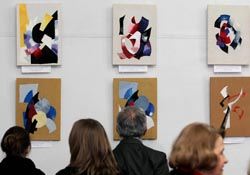Avant-garde embroidery
Masters reproduce the works of renowned artists
Ukrainian avant-garde is scattered over the world. The works of the artists representing this genre have largely “settled” in foreign museum collections, private collections, or were unmercifully destroyed. Work aimed at reproducing those masterpieces and bringing them back to Ukraine requires a great deal of commitment. The exhibit called Revived Masterpieces held in the Museum of Ukrainian Folk Decorative Art features original items – pictures executed using various embroidering techniques by Ukrainian masters, based on the sketches of Kazimir Malevich, Liubov Popova, Olha Rozanova, Oleksandra Ekster, and Vasyl Krychevsky.
“Back in early 20th century the embroidery workshops of the villages Verbivka and Skoptsi of the Poltava province held an interesting experiment of creative cooperation between avant-garde artists and Ukrainian folk masters Hanna Sobachko, Yevmen Pshechenko, Vasyl Dovhoshyia,” Tetiana Kara-Vasylieva, Doctor in Art Studies told The Day. “Unfortunately, most of the embroideries created in that period have been lost, with the exception of several patterns. Studying the archival materials of the responses to the triumphant foreign exhibits of these works, held in 1915-17, I came up with an idea to repeat the experience of our predecessors.”
At the turn of the last century Ukrainian folk embroidery essentially broadened its horizons and split into several styles. Along with the monastery and manorial styles, the avant-garde styled embroidery, based on the works of famous artists, developed quite successfully. Moreover, both Kazimir Malevich, and Oleksandra Ekster began their artistic careers from embroidery patterns. A look at the history of artistic trends over the verge of centuries will divulge a tendency for synthesis of art styles, so as to reveal new forms of the content of what is being depicted. Noted theoretician and artist of the time, Vasyl Kandinsky, went on to seek and borrow the means of expression of spiritual things from various kinds of art, hence combining music and painting. Similarly, embroidery and painting became wedded by the zeitgeist.
The project Revived Masterpieces has been going on for three years, within which the supervisor of the project, Tetiana Kara-Vasylieva together with her scholarly consultant, Doctor of Art Studies at the Russian Academy of Arts, Grigorii Kovalenko, have carried out research on the subject and published an album-book. They have also found original patterns and contemporary masters of the arts, together with the assistance of the charity organization, Presidential Foundation of Leonid Kuchma “Ukraine.” The works of avant-garde artists have been revived through embroidery by teachers and students of the Kyiv-based Boichuk State Istitute of Decorative and Applied Arts and Design, including V. Kostiukova, L. Avdeieva, and I. Zhurakivska. Some works have been embroidered under extreme conditions. In order to be able to present, at the exhibit, an embroidered picture based on the pattern of Kazimir Malevich, which he deveoped at a workshop in the village of Verbivka, Valentyna Kostiukova, Ph.D. at the Kyiv Institute of Decorative and Applied Arts and Design, had to do the embroidery within a period of 10 days. The problem was that the original was kept in New York and was only recently transferred to Ukraine, owing to the efforts of Kovalenko.
At the exhibit one can see the original embroidered works and decorative painting executed by Yevhenia Prybytska, Halyna Sobachko-Shostak, and Vasyl Dovhoshyia. The works of the contemporaries can be compared with the original patterns presented at the exhibit. One of these is the watercolor Bird painted by Volodymyr Dovhoshyia in 1942, which was also reproduced by Kostiukova. The work is dominated by the Poltava satin stitch, known today in rushnyks, where embroidery is performed according to a free contour without counting thread, in compliance with the drawing, as well as art embroidery, feather stitch, stitch on the pattern etc.
“The embroidery is executed, taking into consideration the time layers, which has left its mark of faded paints on the pattern. The works reproduced through embroidery seem to be brighter, and in order to make them closer to the original, one should use several threads at a time, so-called melange, in order to achieve the needed colour tint,” Valentyna Kostiukova said.






